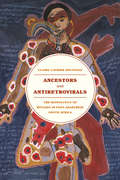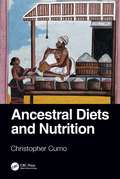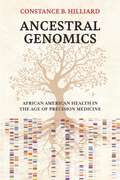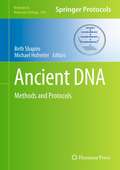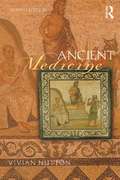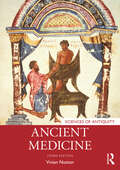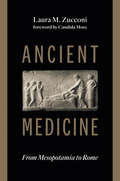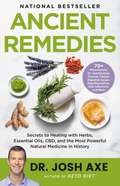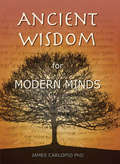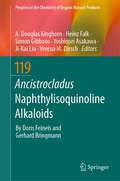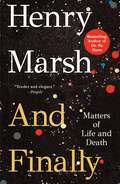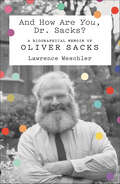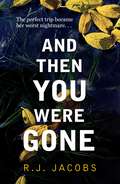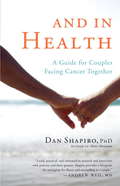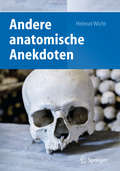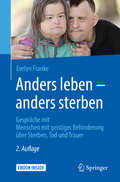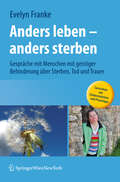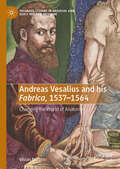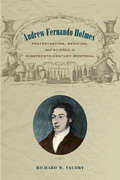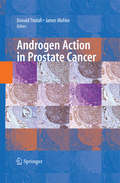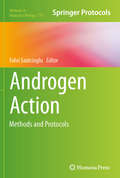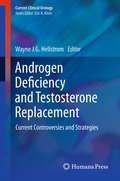- Table View
- List View
Ancestors and Antiretrovirals: The Biopolitics of HIV/AIDS in Post-Apartheid South Africa
by Claire Laurier DecoteauIn the years since the end of apartheid, South Africans have enjoyed a progressive constitution, considerable access to social services for the poor and sick, and a booming economy that has made their nation into one of the wealthiest on the continent. At the same time, South Africa experiences extremely unequal income distribution, and its citizens suffer the highest prevalence of HIV in the world. As Archbishop Desmond Tutu has noted, AIDS is South Africa s new apartheid. In "Ancestors and Antiretrovirals," Claire Laurier Decoteau backs up Tutu s assertion with powerful arguments about how this came to pass. Decoteau traces the historical shifts in health policy after apartheid and describes their effects, detailing, in particular, the changing relationship between biomedical and indigenous health care, both at the national and the local level. Decoteau tells this story from the perspective of those living with and dying from AIDS in Johannesburg s squatter camps. At the same time, she exposes the complex and often contradictory ways that the South African government has failed to balance the demands of neoliberal capital with the considerable health needs of its population. "
Ancestors and Antiretrovirals: The Biopolitics of HIV/AIDS in Post-Apartheid South Africa
by Claire Laurier DecoteauIn the years since the end of apartheid, South Africans have enjoyed a progressive constitution, considerable access to social services for the poor and sick, and a booming economy that has made their nation into one of the wealthiest on the continent. At the same time, South Africa experiences extremely unequal income distribution, and its citizens suffer the highest prevalence of HIV in the world. As Archbishop Desmond Tutu has noted, “AIDS is South Africa’s new apartheid.” In Ancestors and Antiretrovirals, Claire Laurier Decoteau backs up Tutu’s assertion with powerful arguments about how this came to pass. Decoteau traces the historical shifts in health policy after apartheid and describes their effects, detailing, in particular, the changing relationship between biomedical and indigenous health care, both at the national and the local level. Decoteau tells this story from the perspective of those living with and dying from AIDS in Johannesburg’s squatter camps. At the same time, she exposes the complex and often contradictory ways that the South African government has failed to balance the demands of neoliberal capital with the considerable health needs of its population.
Ancestral Diets and Nutrition
by Christopher CumoAncestral Diets and Nutrition supplies dietary advice based on the study of prehuman and human populations worldwide over the last two million years. This thorough, accessible book uses prehistory and history as a laboratory for testing the health effects of various foods. It examines all food groups by drawing evidence from skeletons and their teeth, middens, and coprolites along with written records where they exist to determine peoples&’ health and diet. Fully illustrated and grounded in extensive research, this book enhances knowledge about diet, nutrition, and health. It appeals to practitioners in medicine, nutrition, anthropology, biology, chemistry, economics, and history, and those seeking a clear explanation of what humans have eaten across the ages and what we should eat now. Features: Sixteen chapters examine fat, sweeteners, grains, roots and tubers, fruits, vegetables, and animal and plant sources of protein. Integrates information about diet, nutrition, and health from ancient, medieval, modern and current sources, drawing from the natural sciences, social sciences, and humanities. Provides comprehensive coverage based on the study of several hundred sources and the provision of over 2,000 footnotes. Presents practical information to help shape readers&’ next meal through recommendations of what to eat and what to avoid.
Ancestral Genomics: African American Health in the Age of Precision Medicine
by Constance B. HilliardA leading evolutionary historian offers a radical solution to racial health disparities in the United States.Constance B. Hilliard was living in Japan when she began experiencing joint pain. Her doctor diagnosed osteoarthritis—a common ailment for someone her age. But her bloodwork showed something else: Hilliard, who had never had kidney problems, appeared to be suffering from renal failure. When she returned to Texas, however, a new round of tests showed that her kidneys were healthy. Unlike the Japanese doctor, her American primary care provider had checked a box on her lab report for “African American.” As a scholar of scientific racism, Hilliard was perplexed. Why should race, which experts agree has no biological basis, matter for getting accurate test results?Ancestral Genomics is the result of Hilliard’s decade-long quest to solve this puzzle. In a masterful synthesis of evolutionary history, population genetics, and public health research, she addresses the usefulness of race as a heuristic in genomic medicine. Built from European genetic data, the Human Genome Project and other databases have proven inadequate for identifying disease-causing gene variants in patients of African descent. Such databases, Hilliard argues, overlook crucial information about the environments to which their ancestors’ bodies adapted prior to the transatlantic slave trade. Hilliard shows how, by analyzing “ecological niche populations,” a classification model that combines family and ecological histories with genetic information, our increasingly advanced genomic technologies, including personalized medicine, can serve African Americans and other people of color, while avoiding racial essentialism.Forcefully argued and morally urgent, Ancestral Genomics is a clarion call for the US medical community to embrace our multigenomic society.
Ancient DNA: Methods and Protocols (Methods in Molecular Biology #840)
by Michael Hofreiter Beth ShapiroResearch into ancient DNA began more than 25 years ago with the publication of short mitochondrial DNA sequence fragments from the quagga, an extinct relative of the zebra. Ancient DNA research really gained momentum following the invention of PCR, which allowed millions of copies to be made of the few remaining DNA molecules preserved in fossils and museum specimens. In Ancient DNA: Methods and Protocols expert researchers in the field describe many of the protocols that are now commonly used to study ancient DNA. These include instructions for setting up an ancient DNA laboratory, extraction protocols for a wide range of different substrates, details of laboratory techniques including PCR and NGS library preparation, and suggestions for appropriate analytical approaches to make sense of the sequences obtained. Written in the highly successful Methods in Molecular BiologyTM series format, chapters include introductions to their respective topics, lists of the necessary materials and reagents, step-by-step, readily reproducible laboratory protocols, and key tips on troubleshooting and avoiding known pitfalls. Authoritative and practical, Ancient DNA: Methods and Protocols seeks to aid scientists in the further study of ancient DNA and the methodological approaches in ancient research.
Ancient Medicine (Sciences of Antiquity)
by Vivian NuttonThe first edition of Ancient Medicine was the most complete examination of the medicine of the ancient world for a hundred years. The new edition includes the key discoveries made since the first edition, especially from important texts discovered in recent finds of papyri and manuscripts, making it the most comprehensive and up-to-date survey available. Vivian Nutton pays particular attention to the life and work of doctors in communities, links between medicine and magic, and examines the different approaches to medicine across the ancient world. The new edition includes more on Rufus and Galen as well as augmented information on Babylonia, Hellenistic medicine and Late Antiquity. With recently discovered texts made accessible for the first time, and providing new evidence, this broad exploration challenges currently held perspectives, and proves an invaluable resource for students of both classics and the history of medicine.
Ancient Medicine (Sciences of Antiquity)
by Vivian NuttonThe third edition of this magisterial account of medicine in the Greek and Roman worlds, written by the foremost expert on the subject, has been updated to incorporate the many new discoveries made in the field over the past decade. This revised volume includes discussions of several new or forgotten works by Galen and his contemporaries, as well as of new archaeological material. RNA analysis has expanded our understanding of disease in the ancient world; the book explores the consequences of this for sufferers, for example in creating disability. Nutton also expands upon the treatment of pre-Galenic medicine in Greece and Rome. In addition, subtitles and a chronology will make for easier student consultation, and the bibliography is substantially revised and updated, providing avenues for future student research. This third edition of Ancient Medicine will remain the definitive textbook on the subject for students of medicine in the classical world, and the history of medicine and science more broadly, with much to interest scholars in the field as well.
Ancient Medicine: From Mesopotamia to Rome
by Laura M. ZucconiThis book by Laura Zucconi is an accessible introductory text to the practice and theory of medicine in the ancient world. In contrast to other works that focus heavily on Greece and Rome, Zucconi&’s Ancient Medicine covers a broader geographical and chronological range. The world of medicine in antiquity consisted of a lot more than Hippocrates and Galen.Zucconi applies historical and anthropological methods to examine the medical cultures of not only Mesopotamia, Egypt, Greece, and Rome but also the Levant, the Anatolian Peninsula, and the Iranian Plateau. Devoting special attention to the fundamental relationship between medicine and theology, Zucconi&’s one-volume introduction brings the physicians, patients, procedures, medicines, and ideas of the past to light.
Ancient Medicine: From Mesopotamia to Rome
by Laura M. ZucconiThis book by Laura Zucconi is an accessible introductory text to the practice and theory of medicine in the ancient world. In contrast to other works that focus heavily on Greece and Rome, Zucconi&’s Ancient Medicine covers a broader geographical and chronological range. The world of medicine in antiquity consisted of a lot more than Hippocrates and Galen.Zucconi applies historical and anthropological methods to examine the medical cultures of not only Mesopotamia, Egypt, Greece, and Rome but also the Levant, the Anatolian Peninsula, and the Iranian Plateau. Devoting special attention to the fundamental relationship between medicine and theology, Zucconi&’s one-volume introduction brings the physicians, patients, procedures, medicines, and ideas of the past to light.
Ancient Remedies: Secrets to Healing with Herbs, Essential Oils, CBD, and the Most Powerful Natural Medicine in History
by Dr. Josh AxeBestselling author Dr. Josh Axe explains how to treat more than seventy diseases, lose weight, and increase vitality with traditional healing practices passed down through the ages.Long before the first pharmaceutical companies opened their doors in the 1850s, doctors treated people, not symptoms. And although we've become used to popping pills, Americans have finally had it with the dangerous side effects, addiction and over-prescribing—and they're desperate for an alternative.Here's the good news: That alternative has been here all along in the form of ancient treatments used for eons in traditional Chinese, Ayurvedic and Greek medicine. Ancient Remedies is the first comprehensive layman's guide that will bring together and explain to the masses the very best of these time-tested practices.In Ancient Remedies, Dr. Axe explores the foundational concepts of ancient healing—eating right for your type and living in sync with your circadian clock. Readers will learn how traditional practitioners identified the root cause of each patient's illness, then treated it with medicinal herbs, mushrooms, CBD, essential oils, and restorative mind-body practices. What's more, they'll discover how they can use these ancient treatments themselves to cope with dozens of diseases, from ADHD to diabetes, hypothyroidism, autoimmune disease, and beyond.Through engaging language and accessible explanations, Ancient Remedies teaches readers everything they need to know about getting, and staying, healthy—without toxic, costly synthetic drugs.
Ancient Wisdom for Modern Minds: A Thinking Heart and a Feeling Mind
by James CarlopioThoughts, reflections and experiences voiced by ancient sages appear in this book as 'coaching conversations'. Their wisdom creates a vibrant landscape populated with insights which help us to reflect upon and discuss emotions encountered in personal transformation and constant workplace change. They allow us to process past experiences and emotions in order to move on. James Carlopio shows us that coaching for personal improvement has occurred since time-immemorial. These ancient quotes illuminate modern-day socio-cognitive constructs and techniques used in coaching psychology. The 'coaching conversation' itself is grounded in the constructivist-narrative approaches used within Solution-Focused Brief Therapy. These ancient quotes will assist readers to undergo personal transitions, Executive Coaches to facilitate workplace change and Life Coaches in personal development. Positive Psychology and important areas in coaching psychology are referenced in the Introduction and section openings. Supported by a subject index, this luminous work is grouped into sections addressing: awareness of self and others life, death, health and happiness wisdom, communication and learning achievement, goals and effort The text is designed to help people access emotion, express emotion, acknowledge emotion, release emotion and move on gracefully to happier, more successful and less stressed lives.
Ancistrocladus Naphthylisoquinoline Alkaloids (Progress in the Chemistry of Organic Natural Products #119)
by A. Douglas Kinghorn Heinz Falk Simon Gibbons Yoshinori Asakawa Ji-Kai Liu Verena M. DirschThis book describes a unique class of secondary metabolites, the mono- and dimeric-naphthylisoquinoline alkaloids. They exclusively occur in lianas of the palaeotropical Ancistrocladaceae and Dioncophyllaceae plant families. Their unprecedented structures include stereogenic centers and rotationally hindered, and therefore stereogenic, axes. Extended recent investigations on six Ancistrocladus species from Asia, as reported in this contribution, shed light on their fascinating phytochemical productivity, with over 100 intriguing natural products. This high chemodiversity arises from a similarly unique biosynthesis from acetate-malonate units, following a novel polyketidic pathway to plant-derived isoquinoline alkaloids. Some of the compounds show most promising anti-parasitic activities. Additionally, strategies for the regio- and stereoselective total synthesis of the alkaloids, including the directed construction of the chiral axis, are also presented.
And Finally: Matters of Life and Death
by Henry MarshFrom the bestselling neurosurgeon and author of Do No Harm, comes Henry Marsh's And Finally, an unflinching and deeply personal exploration of death, life and neuroscience.As a retired brain surgeon, Henry Marsh thought he understood illness, but he was unprepared for the impact of his diagnosis of advanced cancer. And Finally explores what happens when someone who has spent a lifetime on the frontline of life and death finds himself contemplating what might be his own death sentence.As he navigates the bewildering transition from doctor to patient, he is haunted by past failures and projects yet to be completed, and frustrated by the inconveniences of illness and old age. But he is also more entranced than ever by the mysteries of science and the brain, the beauty of the natural world and his love for his family. Elegiac, candid, luminous and poignant, And Finally is ultimately not so much a book about death, but a book about life and what matters in the end.
And How Are You, Dr. Sacks?: A Biographical Memoir of Oliver Sacks
by Lawrence Weschler“A wonderful portrayal of a brilliant, eccentric man,” this biographical memoir by an award-winning author is the untold story of Dr. Oliver Sacks (People).Lawrence Weschler began spending time with Oliver Sacks in the early 1980s, when he was profiling the neurologist for The New Yorker. Almost a decade earlier, Dr. Sacks had published Awakenings—the account of his long-dormant patients’ miraculous return to life. Over the ensuing four years, the two men worked closely together until, for personal reasons, Sacks asked Weschler to abandon the profile. The two remained close friends over the next thirty years and then, just as Sacks was dying, he urged Weschler to take up the project once again. This book is the result of that entreaty.Weschler sets Sacks’s brilliant personality in vivid relief. We see Sacks rowing and ranting and caring deeply; composing the essays that would form The Man Who Mistook His Wife for a Hat and waging intellectual war against a medical and scientific establishment that failed to address his greatest concern: the spontaneous specificity of the individual human soul. Here is the definitive portrait of Sacks, whose entire practice revolved around the single fundamental question he asked each of his patients: How are you? Which is to say, How do you be?A question which Weschler, with this book, turns back on the good doctor himself.“Engrossing. . . . This is Sacks at full blast: on endless ward rounds, observing his post-encephalitic patients . . . exulting over horseshoe crabs and chunks of Iceland spar.” —Barbara Kiser, Nature“Thoroughly engaging and enchanting.” —Kirkus Reviews, starred review“Does a particularly good job intertwining Sacks’s searching empathy with his sheer strangeness.” —New York Times Book Review
And Then You Were Gone: the compulsive psychological thriller 'that takes hold and won't let go'
by R. J. JacobsTHEIR PERFECT TRIP... BECAME HER WORST NIGHTMARE.And Then You Were Gone is a totally addictive and twisting psychological thriller that will grip you from the very first page. Perfect for fans of Clare Mackintosh, Lisa Jewell, Fiona Barton, Shari Lapena and B.A. Paris.'A thrilling ride that kept me guessing until the end . . . Exceptional!' Rena Olsen, author of The Girl Before'A gripping psychological thriller filled with suspenseful twists and turns!' Brad Thor, number one bestselling author.For once, Emily Firestone feels her life is coming together. She has a great job and a boyfriend, Paolo, who adores her. So when Paolo suggests a weekend boating trip, it sounds idyllic - wine, water, and the man she loves. But when Emily wakes the morning after they set sail the boat is adrift... and Paolo has vanished. A strong swimmer, there is no way Paolo drowned. So how did he disappear? The days pass without any answers and Emily's world begins to fall apart. As the prime suspect she must do everything to clear her name...but what hidden secrets will she uncover in search of the truth?'Compulsively readable...this psychological thriller takes hold and won't let go.' Publishers WeeklyWHY READERS ARE COMPLETELY GRIPPED:'One of those psychological thrillers you absolutely cannot put down' ***** Goodreads reviewer'What a gripping ride, a psychological thriller with a difference, I could not put this book down.' ***** Goodreads reviewer'The story had me hooked from the first page...'Unputdownable' fits this book better than anything.' ***** Goodreads reviewer'A real rollercoaster of a read!' ***** Goodreads reviewer
And in Health: A Guide for Couples Facing Cancer Together
by Dan ShapiroThis book offers engaging and digestible lessons for couples navigating the life change that a cancer diagnosis brings. Dan Shapiro draws on his more than twenty-five years of clinical work as a health psychologist who has researched and worked with couples facing cancer, and on his own experiences of being both the patient (having and beating Hodgkin's lymphoma in his twenties) and the supporter/advocate (when his wife was diagnosed with breast cancer) to weave together insights on facing cancer while maintaining a strong relationship. And in Health gives advice in short lessons on the main areas of concern or conflict that can come from life with cancer--from diagnosis to treatment and life post-treatment.Topics include: * How to forge yourselves into a powerful team and evade common conflicts * Dealing with physicians and getting the best care possible, along with tips for navigating the medical world * Strategies for coping with the emotions that can interfere with your relationship--anger, mood swings, spouse fears, and depression * Distinguishing between supportive and draining people in your lives, and learning to invite and accept help * Opening to new types of intimacy and making peace with dependence
Andere anatomische Anekdoten
by Helmut WichtDer Autor ist ein Anatom, dem so mancherlei durch den Kopf geht, und eh' er es vergisst, schreibt er's auf. Oft sind es melancholische Gedanken, manchmal garstige, und manchmal welche, die er erheiternd findet. Versuchen Sie, die Geschichten als "Miniaturen" zu lesen. Filigrane, oft ein wenig umständliche und versponnene Spielereien über ein Thema, einen Gedanken, eine Beobachtung, ein Wort. Stimmungsbilder. Nehmen Sie das Büchlein nicht allzu ernst - das ist kein Sachbuch, kein Pamphlet, der Autor hat kein Anliegen, hat nicht die Absicht, Sie zu lehren. Er will Sie unterhalten, vielleicht hie und da verwundern und Ihnen die Anatomie als etwas näherbringen, was sie auch ist: ein ästhetisches, ein sprachverliebtes Fach. Nehmen Sie es doch ernst - was hier drinnen steht, ist wahr. Wahr in dem Sinne, dass die anatomischen und sonstigen wissenschaftlichen Sachverhalte, von denen die Rede sein wird, bis ins Detail so sind, wie sie beschrieben werden; wahr in dem Sinne, dass die Ereignisse, die geschildert werden, sich wirklich so ähnlich ereignet haben.
Anders leben - anders sterben: Gespräche mit Menschen mit geistiger Behinderung über Sterben, Tod und Trauer
by Evelyn FrankeMit Sterben und Tod besch#65533;ftigt sich jeder Mensch im Laufe des Lebens, auch Menschen mit geistiger Behinderung. Diese Menschen haben jedoch besondere Bed#65533;rfnisse: Ihr Zugang und Wissensstand unterscheiden sich oft deutlich von denen anderer Menschen, und dies f#65533;hrt im Betreuungsalltag oft zu Unsicherheiten. Die Autorin skizziert die Todes- und Lebenskonzepte von Menschen mit geistiger Behinderung und stellt ein Schulungsprogramm f#65533;r sie vor zu Lebensphasen, Palliativpflege, Sterben, Tod und Trauer. Mit methodischen Hinweisen und Praxistipps.
Anders leben - anders sterben: Gespräche mit Menschen mit geistiger Behinderung über Sterben, Tod und Trauer
by Evelyn FrankeMit Sterben und Tod beschäftigt sich jeder Mensch im Laufe des Lebens, auch Menschen mit geistiger Behinderung. Diese Menschen haben jedoch besondere Bedürfnisse: Ihr Zugang und Wissensstand unterscheiden sich oft deutlich von denen anderer Menschen, und dies führt im Betreuungsalltag oft zu Unsicherheiten. Die Autorin skizziert die Todes- und Lebenskonzepte von Menschen mit geistiger Behinderung und stellt ein Schulungsprogramm für sie vor zu Lebensphasen, Palliativpflege, Sterben, Tod und Trauer. Mit methodischen Hinweisen und Praxistipps.
Andreas Vesalius and his Fabrica, 1537-1564: Changing the World of Anatomy (Palgrave Studies in Medieval and Early Modern Medicine)
by Vivian NuttonThis monograph presents a study of the most significant book in the history of anatomy, Fleming Andreas Vesalius’ (1514-1564) De humani corporis fabrica. Vesalius’ Fabrica was immediately recognised as changing the view of the human body when it was published in 1543, and it remains iconic today. Despite this, little has been written about Vesalius’ later revisions and corrections to the work, as well as his annotations leading up to the book. The author addresses this lacuna by examining the Fabrica from its inception in Paris in the 1530s, through its publication in 1543, to subsequent revisions and its present status as an expensive treasure. The book also contains new discoveries about the period of Vesalius’ earliest publications from 1537-8, the printing and production of the 1543 Fabrica, and the extensive remaking of the 1555 edition. Chapters also explore Vesalius’ background in new humanist medicine and anatomical teaching in Paris and Italy, the verbal message that the Fabrica was intended to convey, and the immediate responses to the book.
Andrew Fernando Holmes: Protestantism, Medicine, and Science in Nineteenth-Century Montreal
by Richard VaudryThis is the first comprehensive study of the life and work of Andrew Fernando Holmes, famous for his work on congenital heart disease. Physician, surgeon, natural historian, educator, Protestant evangelical. Andrew Fernando Holmes’s name is synonymous with the McGill medical faculty and with the discovery of a congenital heart malformation known as the "Holmes heart." He also played a critical role in the creation of a scientific culture in early-nineteenth-century Montreal. Born in captivity at Cadiz, Spain, Holmes immigrated to Lower Canada in the first decade of the nineteenth century. He arrived in a province that was experiencing profound social, economic, and cultural change as the result of a long process of integration into the British Atlantic world. A transatlantic perspective, therefore, undergirds this biography, from an exploration of how Holmes’s family members were participants in an Atlantic world of trade and consumption, to explaining how his educational experiences at Edinburgh and Paris informed his approach to the practice of medicine, medical education, and medical politics.
Andrews' Diseases of the Skin: Clinical Dermatology
by William D. James Dirk M. Elston Timothy G. BergerEffectively diagnose and treat a wide range of skin conditions with the latest edition of the highly regarded Andrews' Diseases of the Skin: Clinical Dermatology. The 12th edition of this classic reference, by esteemed authors William D. James, MD, Timothy G. Berger, MD, and Dirk M. Elston, MD, provides state-of-the-art information on newly recognized diseases, new conditions, and unusual variants of well-known diseases, as well as new uses for tried-and-true medications and unique drugs for diseases as disparate as melanoma and rosacea. It's your ideal go-to resource for clinical dermatology, at every stage of your career.
Androgen Action in Prostate Cancer
by James Mohler Donald TindallAndrogens are critical regulators of prostate differentiation and function, as well as prostate cancer growth and survival. Therefore, androgen ablation is the preferred systemic treatment for disseminated prostate cancer. Androgen action is exerted in target tissues via binding the androgen receptor (AR), a nuclear receptor transcription factor. Historically, the gene expression program mediated by the AR has been poorly understood. However, recent gene expression profiling and more traditional single-gene characterization studies have revealed many androgen-regulated genes that are important mediators of androgen action in both normal and malignant prostate tissue. This book will focus on the androgen-regulated gene expression program, and examine how recently identified androgen-regulated genes are likely to contribute to the development and progression of prostate cancer. Recent studies that have attempted to unravel how these genes are deregulated in androgen depletion independent prostate cancer will be included
Androgen Action: Methods and Protocols (Methods in Molecular Biology #776)
by Fahri SaatciogluAndrogens play a critical role in the development and maintenance of the male reproductive system and affect important physiological processes and pathological conditions, including the homeostasis of the normal prostate and prostate cancer. Androgen Action: Methods and Protocols is designed to provide a tool box to study various phases of androgen action, from its entry to the cell to the phenotypic response that the cell mounts, with up-to-date techniques for biochemists, molecular biologists, cell biologists, geneticists, and pathologists. The volume opens with a brief review of the research history on androgen action and prostate carcinogenesis, followed by chapters that cover state-of-the-art methods to determine androgen levels in biological tissues and fluids, experimental procedures to study the various aspects of androgen receptor activity, and methodology to study salient examples of interactions between androgen signalling and other major signalling pathways in cells. Written in the successful Methods in Molecular BiologyTM series format, chapters include introductions to their respective topics, lists of the necessary materials and reagents, step-by-step, readily reproducible protocols, and notes on troubleshooting and avoiding known pitfalls. Authoritative and easily accessible, Androgen Action: Methods and Protocols provides a comprehensive overview of, and practical guidance on, the diverse methodologies that are propelling androgen action research forward, both for normal physiology as well as in disease states.
Androgen Deficiency and Testosterone Replacement: Current Controversies and Strategies (Current Clinical Urology)
by Wayne J.G. HellstromAndrogen Deficiency and Testosterone Replacement: Current Controversies and Strategies explores the difficulties around the diagnosis and treatment of androgen deficiency. The text examines the available evidence concerning the diagnosis and treatment of men with low testosterone. It also examines controversies in the identification and management of these men. While the information contained within will be of use to those who specialize in androgen deficiency and sexual medicine, the scope of the book will serve as a source of basic information about testosterone replacement and as a source of reasoned analysis of the controversies surrounding testosterone replacement in the aging male. Physicians and physician extenders will be able to apply evidence management principles to the evaluation and treatment of men with testosterone deficiency; supported by the most recent practice guidelines available. The authors represent a select group of physicians with expertise in androgen deficiency and replacement. Androgen Deficiency and Testosterone Replacement: Current Controversies and Strategies will be of great value to all physicians and physician extenders who deliver health care to men of all ages.
